There are two paths through the windings from any bar in commutator motor of this type to any other, so a high reading indicates that one of those paths has broken or burned out.
Before you bother to do anything with the winding, feel, or ideally measure with a dial gauge, whether the bar that has the burn mark on it is any higher than the others. If it is, and this is common, the insulation material below that bar has been damaged, and the commutator is unusable.
Unwinding - you need to determine three things as you unwind:
The number of turns in each coil. Power tool armatures commonly have multiple coils in each slot, often 24 commutator bars to 12 slots, giving two coils in each slot.
The gauge of wire used. Since the armature will be varnished, it can be difficult to get an exact measurement, but the coil sides towards the bottom of the slot will generally be less well coated, and easier to clean away the varnish - but not the coating on the wire. There are tables online you can use to find the size of the insulated wire vs. the nominal size, such as here
The connection to the commutator. Depending on where the brushes are located relative to the field coils, the coils will likely not be connected to the commutator bar directly under them. There's frequently an advance incorporated (for better brushwear), and on most machine wound armatures, the wire will run around to the opposite side of the commutator, around a hook or 'tang' at the top of the bar, that is later flattened down in a resistance welder, and then around the rest of the way to the next coil.
Here's a link that describes the possible winding patterns you can encounter. Almost all power tools are lap wound, and likely duplex or triplex.

Once you've wound the armature, your next challenge is to connect to the commutator. If you have a large soldering iron, you may be able to solder the wire to the commutator - to do this you need to either carefully scrape off the wire coating, or use a solderable wire, where the coating will burn off under the heat of the iron. This type of wire is less tolerant of heating through overloading, and also mechanical damage during winding, so it isn't that commonly used in commutator armatures. The resistance welded commutators generate enough heat locally to burn off regular wire coating, but care is needed to set up these welders to avoid that heat damaging the rest of the bar.
Finally you need to coat the windings in a varnish. This is an electrical varnish, that is heat tolerant, and also strong enough to stick the winding mass together so that they don't fling out at speed.
I've rewound many armatures - unless it's an unusual motor, and you can't get a replacement it is rarely worth the effort. Finding a local rewinding shop might be an option, but these have disappeared at a rate now that motors from the Far East are so cheap that repair is not that often justified, at least for smaller motors.
